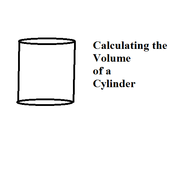

Such a cylindric section of a right cylinder is a rectangle.Ī section of cylinder in which the intersecting plane intersects and is perpendicular to all the elements of the cylinder is called a right section of a cylinder. The section of cylinder by a plane that contains two elements of a cylinder is a parallelogram. The line that the segment is revolved about is called the axis of the cylinder and it passes through the centers of the two bases.Ī section of cylinder is the intersection of a cylinder's surface with a plane. The height of a cylinder of revolution is the length of the generating line segment.

The cylinder obtained by rotating a line segment about a fixed line that it is parallel to is a cylinder of revolution.Ī cylinder of revolution is a right circular cylinder. The height of a cylinder is the perpendicular distance between its bases. Generally we use 'cylinder' to refer a right circular cylinder. If the bases are disks, the cylinder is called a circular cylinder. If the elements of the cylinder are perpendicular to the planes containing the bases, the cylinder is a right cylinder, otherwise it is called an oblique cylinder. The two bases of a cylinder are congruent figures. The region bounded by the cylindrical surface in either of the parallel planes is called the base of the cylinder. The line segments determined by an element of the cylindrical surface between the two parallel planes is called an element of the cylinder.Īll the elements of a cylinder have equal lengths. Any line in this family of parallel lines is called an element of the cylindrical surface.Ī solid bounded by a cylindrical surface and two parallel planes is called a solid cylinder. The cylinder is the idealized version of a solid physical tin can having lids on top and bottom.Ī cylindrical surface is a surface consisting of all the points on all the lines which are parallel to a given line and which pass throughĪ fixed plane curve in a plane not parallel to the given line. JavaScript is currently disabled.Please enable it for a better experience of Jumi.Lets first understand, what is a cylinder and how we can find different properties of a cylinder?Ī cylinder is a 3-D solid and one of the most basic of curvilinear geometric shapes. In this case it will also adjust the sphere power accordingly to maintain the spherical equivalent. Similarly, if the recommended cylinder is -2.75 and the max cyl for the lens is -2.25 it'll recommend this power. For example, if the recommended axis is 87 deg and the lens axes are available in 10 deg steps it will chose the 90 deg option. However, once the ideal lens power is established the calculator looks up the chosen lens brand and finds the powers that are closest to the ideal lens. The calculation solely uses the lens power, lens rotation, and overrefraction to make its suggestion - no considerations are made for lens brand in the calculation. Please note that lens brand does not affect the calculation of the ideal next lens.
Oblique cylinder volume calculator trial#
The calculator also takes into account the brand of trial lens. The final result is a recommendation for a lens that is expected to rotate like the original lens. However, since the trial lens should rotate just like the original, the calculator then subtracts the angle of lens rotation.

After this calculation, we know what power and what meridians make the patient reach their best corrected vision. Once we know how these meridians relate to each other we can then apply traditional oblique crossed cylinder equations. This is the only way to know how the power meridians are going to line up with the meridians of the over refraction. Interpretation: It is assumed that your new trial lens will be of the same brand as the original, and therefore will rotate exactly the same (therefore it's critical that you make an accurate assessment of lens rotation).Įxplanation: This calculator first adds the amount of rotation to the axis of the contact lens. Results: The powers of the suggested lens will appear in the last box.


 0 kommentar(er)
0 kommentar(er)
